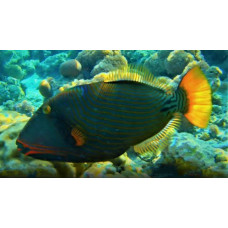Latin name
Balistapus undulatus
Other name
Balistapus undulatus
Identification
This species is characterized by the following features: anterior part of the eye without an elongated groove; enlarged scales above the base of the pectoral fin and just behind the gill opening, forming a flexible membrane; scales on the caudal peduncle with 2 longitudinal rows of large protruding forward spines; slightly rounded caudal fin.
Features of fish fins
Dorsal spines (total): 3; Dorsal soft rays (total): 24-27; Anal spines: 0; Anal soft rays: 20-24.
Fish colouring
Head and body coloration green to brown with diagonal orange lines and a large round black spot covering most of the base of the caudal fin. The rays of the soft dorsal, caudal, anal and pectoral fins are orange. Sexual dimorphism is marked. As males mature, they lose the orange stripes and spots between the mouth and eyes.
Distribution
Inhabit the Red Sea and Indo-Pacific from the coast of East Africa to South Africa, Japan and New Caledonia.
Habitat
Tropical marine species. Lives at depths from 5 to 50 meters. The fish prefers lagoons and outer slopes of reefs with abundant coral vegetation.
Size
The maximum body length is 30 cm. Normal length is 26 cm.
Behavior
Adults, which are territorial by nature, inhabit coral-rich areas of deep lagoons and reefs that face the sea from the lower tidal zone to at least 50 meters.
Food and feeding habits
They feed on a variety of bottom-dwelling organisms such as algae, echinoderms, fish, mollusks, crustaceans, sponges and aquatic invertebrates.
Reproduction
During the breeding season, the fish gather in schools in the fast flowing channels of the reef and spawn in depressions in the sand or coral. Hatching occurs at night. Nests are guarded by one or sometimes two adults.
Fishing
This species is commercially important. It is fished for sale to aquariums.
Relationship with a person
Not suitable for reef aquariums as they are very aggressive towards other fish. Injury-prone species for humans. Can be aggressive towards the keeper.
| Classification | |
| Phylum | Chordata |
| Class | Actinopterygii |
| Squad | Tetraodontiformes |
| Family | Balistidae |
| Genus | Balistapus |
| Species | B. undulatus |
| Features | |
| Conservation status | Least Concern |
| Habitat | Pelagic |
| Life span, years | No information |
| Maximum body weight, kg | No information |
| Maximum length, cm | 30 |
| Sailing speed, m/s | No information |
| Threat to people | Edible |
| Way of eating | Bentophage |
Orange-lined triggerfish
Tags: orange lined triggerfish


